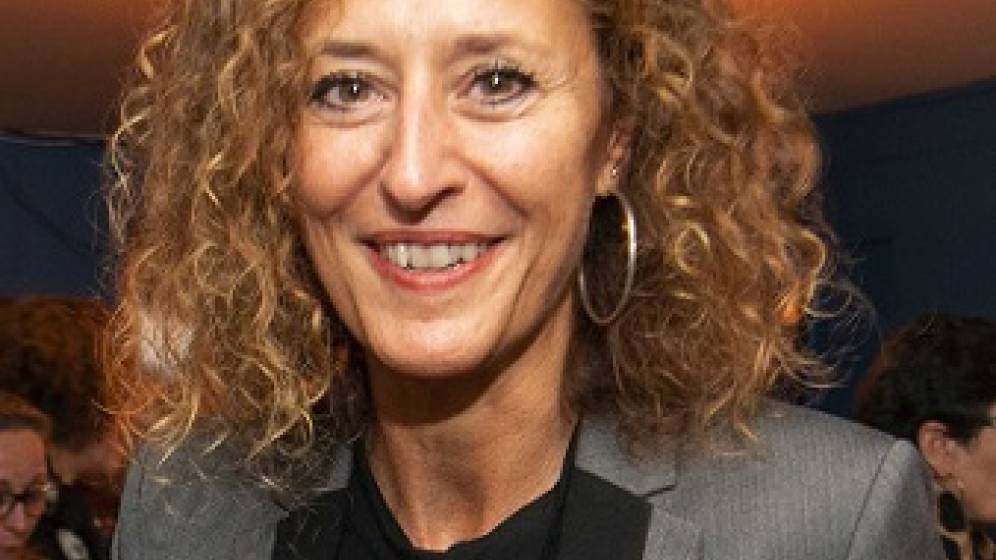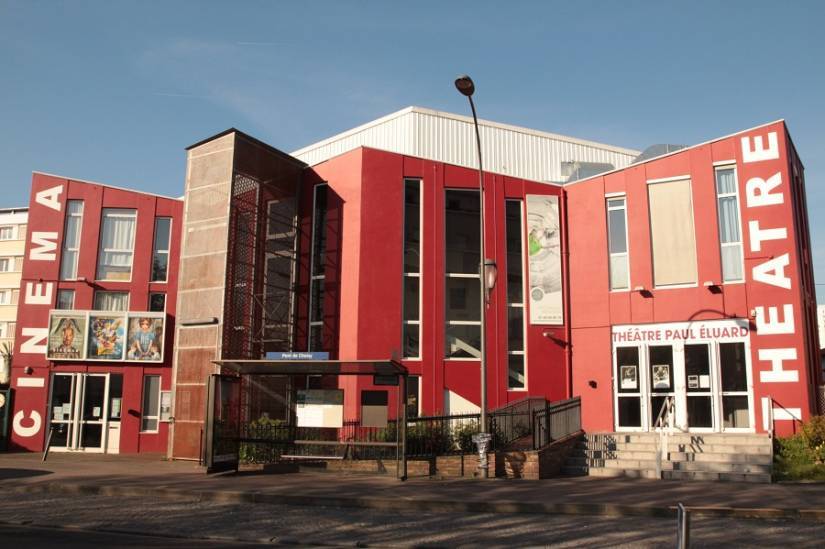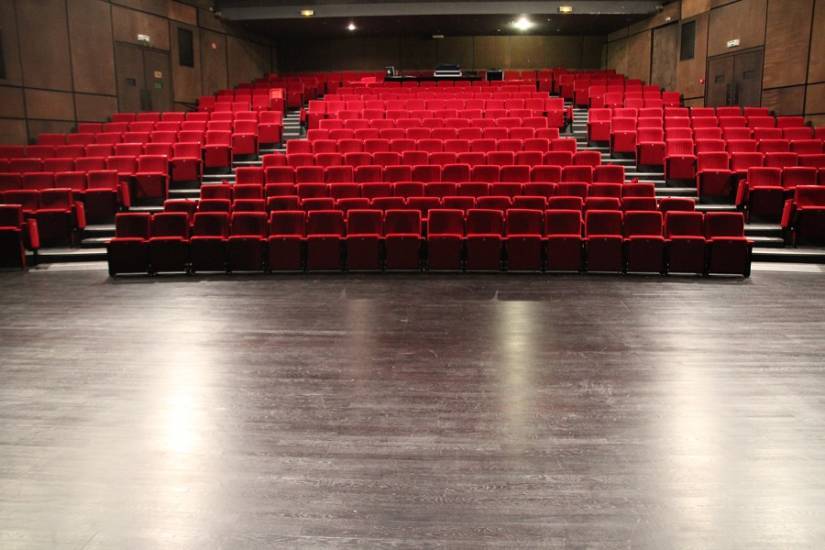"Tenir compte de la réalité des populations, l’intégrer, travailler avec elle par le prisme de la langue, entendre leur richesse, écouter cette culture polyglotte, offrir un lieu de diffusion de spectacles pluridisciplinaires et se battre pour une programmation digne du service public" constituent un terreau fertile et précieux qui "permet de bâtir quelque chose qui a de la pertinence" pour Vanessa Mestre. Le théâtre de Choisy, aujourd’hui, connaît une belle fréquentation. 80% du public est local et cette année, la programmation atteint 70% de femmes. "Il y a même une surreprésentation !"
un théâtre qui travaille pour le bien-être des gens
Un théâtre de ville doit rassembler les populations. Pour la directrice du théâtre de Choisy : création, médiation, éducation artistique ont un véritable sens, une véritable portée. Et puis, il y a la mise en place de résidences : la venue du danseur et chorégraphe congolais, DeLaVallet Bidiefono, qui exprime la langue du corps comme extension du projet; celle de Denis Podalydès, accompagné d'Éric Ruf, de Laurent Mauvignier, qui met en scène L'Orage d'Alexandre Ostrovski, avec cette troupe de comédiens de la Comédie française qui joue durant 3 semaines pendant les vacances de Noël. "Et ce public heureux qui vient vous voir à l’issue du spectacle, c'est vertigineux." Cette année, le théâtre de Choisy accueille, entre autres, Didier Ruiz pour travailler à sa nouvelle création. Offrir une autre manière de voir, de penser, répondre à la charte d’une scène conventionnée "en affirmant l’empreinte civique d’un théâtre dans la cité", est une nécessité pour façonner "un théâtre qui travaille pour le bien-être des gens".
Rencontre avec Vanessa Mestre
La diversité linguistique est-elle l’argument majeur et prédominant dans le développement de la création théâtrale contemporaine pour le théâtre de Choisy ?
"Le théâtre accompagne en coproduction quasiment exclusivement des projets artistiques multilingues qui présentent donc une ou plusieurs langues au plateau, ou d’envergure internationale. La programmation les accueille bien évidemment au sein d’une construction de spectacles éclectiques, d’écriture contemporaine, qui relèvent de différentes esthétiques et pour tous les âges. La diversité linguistique colore ainsi la programmation qui est ouverte sur le monde et ses cultures multiples, avec une ligne de conduite attentive à ce qu’elle ne soit jamais synonyme d’assignation."
Comment définiriez-vous la diversité linguistique ? Et, en quoi cette diversité linguistique est-elle essentielle à vos yeux ?
"Mon projet s’attache à la mise en valeur de la diversité des personnes, des expressions et des territoires dans lesquels le plurilinguisme devient une exigence dans les sociétés actuelles. Sa première fonction est de maintenir la diversité des points de vue, d’ouvrir l’esprit à l’altérité. Je ne peux que citer Michel Serres sur ce qu’il y a au-delà des langues :
"Les langues sont un trésor et véhiculent autre chose que des mots. Leur fonction ne se limite pas au contact et à la communication. Elles constituent d’une part des marqueurs fondamentaux de l’identité, elles sont structurantes, d’autre part, de nos perspectives."
Mes réflexions m’ont ramené sans cesse à la prise en compte de la diversité culturelle, incontournable vis-à-vis du territoire d’implantation du Théâtre et donc du dialogue interculturel qui doit être mené avec l’intérêt de porter un projet tourné vers l’international. Mais inviter et montrer le monde sur une scène ne suffit pas, et après une expérimentation menée sur la diversité linguistique portée par la précédente directrice dont j’étais l’adjointe, j’ai décidé de prolonger une voie unique et singulière et donner un périmètre plus large d’intervention au titre des droits culturels.
Travailler sur les droits culturels, concrètement, c’est dire aux habitants que toutes les cultures dont ils sont dépositaires sont importantes, et c’est permettre à chacun le droit de participer à la vie culturelle.
La scène conventionnée attachée à la mise en valeur de la diversité culturelle en général travaille ainsi de manière plus large à ces enjeux importants, marquant l’empreinte civique d’un théâtre dans la cité.
© Façade du Théâtre et du cinéma de Choisy
La diversité linguistique c’est aussi ouvrir le champ de la définition des langages et notamment de considérer les langages du corps comme partie prenante. Ainsi les créations chorégraphiques sont complètement intégrées dans le périmètre de travail. Je suis également attentive à la LSF en invitant tant que possible des spectacles signés.
Parlez-moi de cette diversité linguistique qui se croise forcément avec la diversité culturelle ?
La culture de la diversité c’est celle de la pluralité des regards, de la pensée et des expressions, dans le respect des singularités.
D’abord la représentativité de la population doit se retrouver sur les scènes comme dans la salle. Il faut aujourd’hui encourager la présence des créateurs et interprètes issus de l’immigration et multiculturels. J’ai constaté que cette meilleure représentativité sur les plateaux favorise une plus grande mixité sociale du public dans les salles.
Dire que toutes les cultures sont importantes, c’est leur donner l’hospitalité et une fenêtre de visibilité en accueillant la programmation internationale dans une portée multiculturelle en faisant place à la diversité des langues, des origines et des cultures qui participent de la richesse des expressions artistiques d’aujourd’hui. Le territoire possède une carte maîtresse : de nombreux habitants ont une histoire internationale. Donner à partager ces formes et récits d’ailleurs, c’est donner une identité artistique à un territoire et réduire la tendance au repli communautaire.
C’est accueillir des artistes présents en France ou en Europe qui se saisissent de leur propre histoire, et qui interrogent à travers le prisme de la scène ce que constitue les questions prégnantes telles que la migration, des artistes qui engagent le public dans l’expérience de l’altérité. C’est valoriser les cultures en présence et également se rapprocher des coopérations que la ville mène, ou encore des dispositifs européens.
© vue de la salle du théâtre Choisy
Un théâtre doit-il faire forcément corps avec le territoire, épouser totalement le lieu où il est implanté ? La place du public ? Doit-on parler d’un territoire ou des territoires ?
"Je répondrai modestement à ma place de directrice d’un théâtre de ville qui en effet reçoit la responsabilité de s’adresser prioritairement à la population locale. L’écriture d’un projet artistique et culturel doit se dresser en fonction d’une situation observable, de la prise en compte des réalités. Et c’est aussi fort de ces spécificités qu’on peut ouvrir des voies nouvelles, des expérimentations et véritablement écrire une histoire à partager avec la population. C’est ce qu’on appelle l’empreinte d’un théâtre dans la cité et c’est pour moi fondamental, que derrière la logique de programmation et de diffusion, il y ait une toile de fond, une colonne vertébrale. La place du public ? Elle est centrale à travers la diffusion, l’EAC, la sensibilisation des publics."
Est-ce difficile de diriger un théâtre ? La passion est-elle la plus grande inspiratrice dans votre mission ?
C’est un métier rare et un privilège, une vocation qui se découvre. Et de grandes responsabilités. Elles sont attenantes à la direction et ses obligations nombreuses mais surtout à la confiance qu’un public vous accorde.
Dans quelques jours, le 8 mars est la Journée internationale des droits des femmes, quel regard porter vous aujourd’hui sur la place des femmes dans l’espace culturel ?
J’ai naturellement écrit une saison qui repose sur plus de 70% de femmes créatrices, autrices, metteuses en scènes. Ce n’était pas un exercice mais la mise en lumière de ce que j’avais envie de partager avec le public cette saison et il s’avère que ce sont majoritairement des femmes. Et tant mieux ! Mon projet aura peine à faire remonter les moyennes qui sont toujours faibles, le secteur professionnel est conscient mais insuffisamment mobilisé sur les questions de parité.
Une scène conventionnée pour la diversité linguistique, c’est quoi ?
Regard sur le projet unique et singulier mené au Théâtre de Choisy-le-Roi
Le Théâtre de Choisy-le-Roi est un lieu de diffusion de spectacles pluridisciplinaires dont une partie de la programmation est dédiée à l’actualité de la scène internationale sous toutes ses formes, et lorsqu’elle s’exprime en mot, les langues originales et étrangères sont privilégiées. Pourquoi ? Parce que le Théâtre est implanté dans une ville riche de sa diversité culturelle et des langues qui y sont parlées et que leur donner l’hospitalité, c’est construire un dialogue original et singulier avec la population.
Cette démarche prend en compte concrètement l’égale dignité des personnes et de leurs cultures et s’empare d’un outil fort des droits culturels. L’accueil de spectacles en langue étrangère ne se réduit pas aux langues les plus facilement croisées sur le territoire car la population polyglotte ne met aucun frein à aller vers des langues qu’elle ne maîtrise pas, elle assimile en priorité que le théâtre est une place ouverte pour y entendre le monde. En témoigne l’accueil cette saison du théâtre thaïlandais de Wichaya Artamat, du "Projet Shaeirat"en langue arabe, ou encore du wolof qui s’invitera dans la dernière création de Mikaël Serre "Dialaw Project".
La direction du Théâtre de Choisy-le-Roi est confiée en 2021 à Vanessa Mestre qui décide de prolonger l’axe de travail expérimental de la scène conventionnée, persuadée que la prise en compte de la diversité culturelle de la population est une démarche incontournable vis-à-vis du territoire et que la présence importante des langues parlées dans la ville est un outil privilégié pour créer du lien. La diversité trouve ainsi sa mise en œuvre concrète au sein du projet comme une composante des droits culturels qui s’expriment, pour continuer à créer des places pour que les artistes et les habitants se rencontrent.
La diversité linguistique c’est aussi l’accueil de la scène contemporaine internationale en invitant au voyage et en éveillant les consciences aux réalités des autres, de manière poétique mais aussi politique.
Le projet déploie son versant du côté du secteur professionnel en accompagnant les équipes artistiques et techniques, aussi bien françaises qu’internationales, à la mise en œuvre de l’adaptation, de la traduction et du sur-titrage, autour de créations qui ont le souhait de s’exporter, d’inviter plusieurs langues au plateau, de revisiter leur sur-titrage ou leur traduction. Ce travail est aussi unique et singulier que ce que peut être une création artistique. Afin de rendre plus lisible son action auprès des professionnels, la deuxième édition du programme de soutien à la diversité linguistique vient d’être publiée sous forme d’appel à projet.
Partager la page


